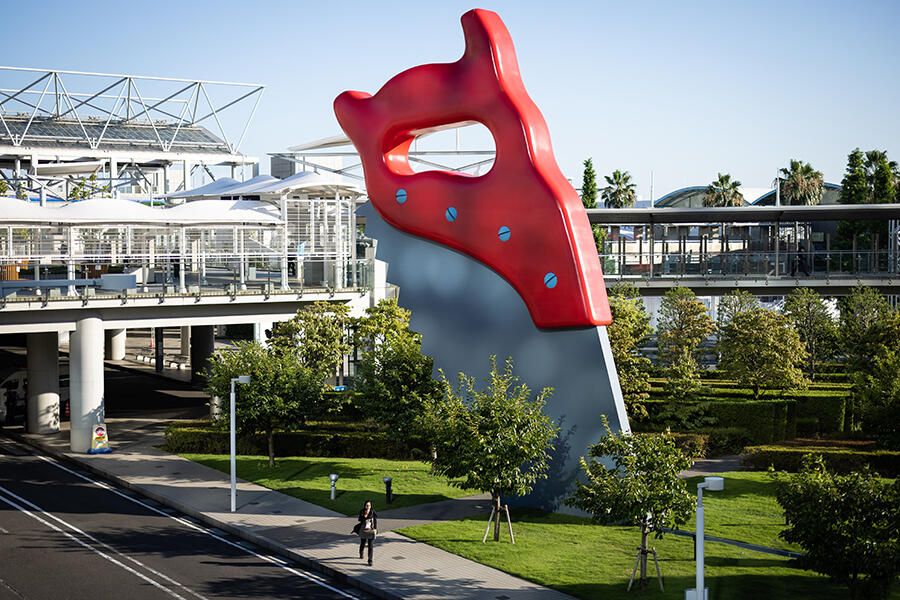Remembering Claes Oldenburg (1929–2022)
Randy Kennedy recalls meeting the seminal pop artist and how his outsize sculptures injected wit and whimsy into the everyday
Randy Kennedy recalls meeting the seminal pop artist and how his outsize sculptures injected wit and whimsy into the everyday

The studio on Broome Street where Claes Oldenburg lived and worked for more than 40 years was almost too Oldenburgian to be believed – a meticulously appointed museum of the self. If Wes Anderson had anatomized it in a film, the camera would have ascended the five floors of the two adjoined industrial buildings slowly, passing through jewel-like spaces housing archives, sculpture (comically oversized pliers and hammers) and acres of white shelves crammed with toys, knickknacks and plain old trash plucked with great delectation from the streets of Manhattan.
Pacing the camera’s progress would have been Oldenburg himself, standing at the helm of the big, hand-operated elevator in which he loved to ferry visitors through his wonderland. When I spent an afternoon with him in 2017, the elevator contained, besides us, a large wooden boat propeller left over from the buildings’ prior life as the Marine Engines Specialties Corporation, a name that sounded itself as if invented by Oldenburg, perhaps as the profit-making division of his fictitious Ray Gun Manufacturing Company.

Paul Van Der Werf
Oldenburg died last week at the age of 93 in his SoHo redoubt, leaving a legacy far more peculiar and individual than those of contemporaries like Jim Dine, James Rosenquist and Andy Warhol. For one thing, he was simply funnier than they were, with a sense of humour that splashed gleefully over the borders of 1960s irony and camp. During an early childhood in Europe – Stockholm and Oslo – he seemed to have picked up loose strands of dada DNA and compounded them, during his Chicago adolescence, with the same raucous, gawdy, Midwestern sensibility that would eventually beget the Hairy Who.
In a series of studio notes Oldenburg made in 1960, four years after moving to New York – and a year before Warhol would make his first pop paintings – he wrote impatiently: ‘Everyone is making paintings and being so frigging artistic.’ He, instead, was making crude plaster reliefs of everyday objects, assembling deadpan American flags from Provincetown driftwood and helping give birth to the happening. ‘Bad taste’, he noted, ‘is the most creative thing there is.’

In truth, he was too much of an old-school aesthete and intellectual to wield bad taste the way his East Village compatriot Boris Lurie, co-founder of the No!art movement, did in projects such as The Vulgar Show (1960). But, seen alongside the work of his pop peers, Oldenburg’s was a direct poke in the eye of American exceptionalism and excess, a stand-up routine by Mort Sahl or Lenny Bruce rather than Nichols and May.
Oldenburg was unafraid of the absurd and the macabre, once proposing a nightly scream to be sounded through the streets of Manhattan at 2am. Most of his best ideas for public art – the towering, everyday-object sculptures for which he is now famous, often conceived with Coosje van Bruggen, his second wife – are the ones never realized because they were intended as pure provocation and civic thought-experiment: Proposal for a Cathedral in the Form of a Sink Faucet for Lake Union, Seattle, Washington (1972); Proposed Colossal Monument for Park Avenue, New York (1967) – a giant bowling ball that would roll repeatedly down the street into a hole near Grand Central; Proposed Monument for the Intersection of Canal Street and Broadway, N.Y.C. – Block of Concrete with the Names of War Heroes (1965) – a multi-ton chunk of inscribed concrete fully obstructing the intersection. (The absence of a permanent Oldenburg public work in New York City, his imaginarium for more than half a century, is nothing less than a crime that should be redressed immediately to honour his memory.)

The time I spent with Oldenburg in the studio that day, to write a profile for T Magazine, ended up being unexpectedly retrospective. From the filing cabinets, he pulled reams of sketches and comics that he’d made in school during the 1940s, many of which were very funny and demonstrated the origins of his extraordinary draftsmanship. His memory was beginning to falter – his daughter, Maartje, sat beside him to supply years and names – and I wondered if he had proposed revisiting his youth because memories of the distant past were beckoning as the present ebbed.
It had been decades since he had gone through his childhood work, and his face lit up as he shuffled through Harvey Kurtzman-like portraits of classmates and precise-seeming drawings of war planes and machinery – a fixation on caricature and structure that remained to the end. After a while, growing bored, or maybe just sceptical of nostalgia, he grabbed his cane and shot me a waggish look over his big, horn-rimmed glasses. ‘Enough of this,’ he said. ‘Let’s go see some things! To the elevator!’
Main image: Claes Oldenburg with one of his works, an outsize tube of toothpaste on display in the Dusseldorf Kunsthalle, West Germany. Courtesy: Keystone/Getty Images
Thumbnail image: Oldenburg poses during the presentation of the exhibition "Claes Oldenburg. The Sixties" at the Guggenheim Bilbao Museum. Courtesy: RAFA RIVAS/AFP via Getty Images





















